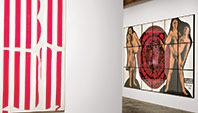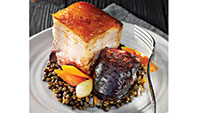
Like the non-famous twin sister of a celebrity, Bordeaux could easily pass for Paris in the warm glow of a wine buzz—in fact, many of the capital’s grandest eighteenth-century boulevards and buildings were modeled after Bordeaux’s, which were collectively granted UNESCO World Heritage Site status in 2007. The most visible difference between the two cities? Bordeaux’s trying a lot harder to win your love—especially as of late. Thanks to a massive, multi-decade revitalization effort, the city’s neoclassical limestone façades have been polished to a gleam, the once derelict riverfront reinvented as a lively pedestrian path, and several outlying (and gentrifying) waterfront neighborhoods united by a new (and still expanding) tram system. Plus, a fleet of Philippe Starck–designed share bikes (with bright-yellow tires) has just hit the streets; the city’s seven largest museums are now free to enter; and 25 acres of green space are being added to the cityscape each year. Below, how Bordeaux stacks up to the City of Light.
The Garonne Instead of the Seine
Over the course of the last fifteen years, the banks of the Garonne River have been cleared of their grim industrial remnants and reimagined with pedestrian walkways, landscaped gardens, bike paths, and a sizable skate park, plus a slew of cafés, bars, and boutiques, many set in converted warehouses and hangars. Adding to the waterfront’s new appeal: the redevelopment of the wet docks (bassins à flot) north of the city center into a thriving arts and nightlife zone. Don’t miss the Garage Moderne (1 Rue des Étrangers; 5650-9133), an auto-repair shop by day and a venue for live music and performance art by night, or the iBoat (iboat.eu), a decommissioned ferry that hosts dance parties, rock bands, and cinema events on weekends.

CAPC Instead of the Centre Pompidou
Opened in 1973 in an 1820s warehouse on the harbor, the CAPC Musée D’Art Contemporain de Bordeaux (7 Rue Ferrere; 5600-8150) may not have quite the catalogue of the capital’s inside-out art museum (with 600 works by 100 artists in its collection, compared with the Pompidou’s 50,000), but it does have seniority: It’s a full four years older than the Pompidou and was the first museum in France to display pieces by Keith Haring, Richard Serra, and Frank Stella. In honor of its 40th anniversary this year, a special commemorative exhibition will be up through December 8, with works by Nan Goldin, Noritoshi Hirakawa, Bernd and Hilla Becher, Peter Halley, and more.
Chartrons Instead of the Marais
The onetime stomping grounds of the city’s wine traders is Bordeaux’s newest bobo district: Chartrons brims with expat-run cafés, boutique hotels like the wacky white cube Seeko’o (from $260; seekoo-hotel.com), and plenty of shopping: Think python-embossed suede booties and metallic leather skirts at Lily Blake (68 Rue Notre Dame; 3305-4140), run by a former London fashion editor; Bordeaux-made Albertine swimwear and Spanish Castañer espadrilles at Pia Pia (71 rue Notre Dame; 5644-5917); and funky furnishings at design destination RKR International (73 Rue Notre Dame; 5679-3573).

Laid-back Gourmandizing Instead of Food Snobbiness
With over 1,000 restaurants—the most per capita of any French city—five with Michelin stars, a good meal is never far in Bordeaux. That said, casual cuisine is the true local specialty. Tips for doing it right: Hit the lower-priced outlets from the city’s top toques—like the first-floor bistro below François Adamski’s Le Gabriel (10 Place de la Bourse; 5630-0080). Or seek out the city’s newest Bib Gourmand, L’Air de Famille (15 Rue Albert Pitres; 5652-1369), a Chartrons restaurant that focuses on seasonal produce. And come Sunday morning, follow the throngs to the Marché des Quais (Quai des Chartrons; no phone), where locals throw back Arcachon oysters pulled from the water that morning.
Drinking—and lots of it Instead of Smoking
Thanks to a new crop of entrepreneurs, Bordeaux’s wine-bar options grow more interesting by the season. A few names making the most of the 8,650 vintners right in their backyards: At Wine and Soul (23 Rue du Couvent; 5777-0986), in Chartrons, the ramshackle furnishings belie owner Jeremy Renard’s serious industry connections (his father is the director of Bordeaux Millésimes). Le Wine Bar (19 rue des Bahutiers; 7600-5054) in the historic St. Pierre district offers a similarly homey vibe, as well as 260 wines to taste and supplementary snacks. And Au Quatre Coins de Vin (8 Rue de la Devise; 5734-3729) keeps a rotation of 32 wines on tap, plus about 200 more that can be sampled from the bottle.


Population: 240,000
Distance from Paris: A three-hour train ride.
Where to Stay: $: The newest outpost of dirt-cheap Philippe Starck hotel mini-chain Mama Shelter (from $67; mamashelter.com) opened its doors just two weeks ago in the thirties-era Gaz Tower downtown. $$: Beloved local chef Jean-Pierre Xiradakis (La Tupina, Kuzina, Au Comestible) recently opened the five-room, eclectic Maison Fredon (from $245; chateauxhotels.com) in a former residential building down the street from his three restaurants. $$$: Luxe wine-country spa resort Les Sources de Caudalie, ten miles from the city center, added nine swanky new rooms this summer in Château Le Thil (from $325; sources-caudalie.com), a centuries-old manse that served as a summer residence for Bordeaux’s mayor in the nineteenth century.